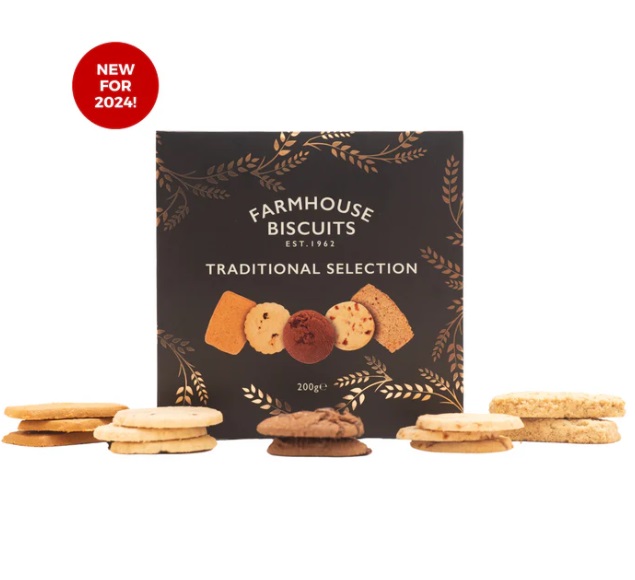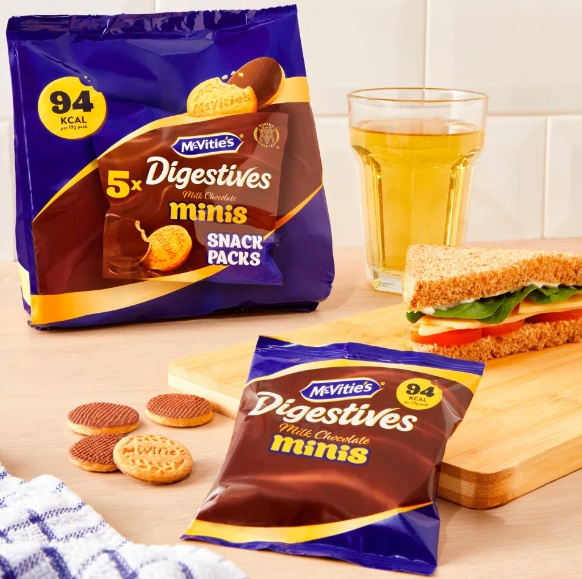
Why Farmhouse Black Traditional Selection Box is a Must-Have for Biscuit Lovers
There’s something undeniably comforting about the timeless simplicity of biscuits. For those who cherish the delicate crunch, the rich flavors,
In the vast tapestry of British culinary traditions,few treats evoke as much nostalgia and debate as mcvitie’s Jaffa cakes. With their delicate balance of sponge, tangy orange jam, and a velvety layer of dark chocolate, these bite-sized wonders have become an enduring favorite across generations. but beyond their irresistible taste lies a rich history peppered with legal battles,cultural meaning,and a fair share of intrigue. Are they cakes or biscuits? What makes them so uniquely British? Join us as we delve into the iconic history of McVitie’s Jaffa Cakes, uncovering the sweet story behind a treat that has captured hearts—and taste buds—for over a century.
in the vibrant culinary landscape of 1927 Britain, McVitie’s introduced a creation that would forever sweeten teatime traditions: the Jaffa Cake. Inspired by the rising popularity of light sponge cakes, the brand embarked on blending delicate textures with bold, zesty flavors. The innovation lay not only in its marriage of sponge, chocolate, and orange but also in the precise balance of sweetness and tanginess that set it apart from other snacks of its era. It was this unique combination that quickly turned the Jaffa Cake into a household name, enjoyed across generations while sparking debates over its classification—is it a cake or a biscuit?
What truly made the Jaffa Cake special was its adaptability to the changing tastes and cultures within the UK. Early advertisements highlighted its three-layer brilliance: the comforting sponge base, the citrusy orange center, and the rich chocolate topping. For curious minds,here’s a breakdown of its original layers that carved its legacy:
| Layer | Description |
|---|---|
| Sponge | Light and airy texture |
| Orange Jelly | Sweet yet tangy citrus flavor |
| Chocolate | Decadent and smooth coating |
The classification of McVitie’s Jaffa Cakes has long been a engaging legal debate,stemming from the deceptively simple question: is it a cake or a biscuit? The conversation gained national attention in 1991,when the matter was taken to court to determine how Jaffa Cakes should be taxed under UK law. Cakes are considered a staple food and exempt from VAT, while biscuits (if coated in chocolate) incur VAT. McVitie’s argued passionately that Jaffa Cakes align with characteristics of cakes, not biscuits. Their evidence? Everything from their texture upon becoming stale to the way they rise when baked. the court ruled in favor of cakes, solidifying Jaffa Cakes as a tax-free treat.The intricacies of these arguments can be broken down into fascinating points that highlight how seemingly trivial details hold significance in law:
| Characteristic | Cake | Biscuit |
|---|---|---|
| VAT Status | Exempt | Taxable (if chocolate-coated) |
| baking Process | Rises like a sponge | Flatter,crumbly |
| Staleness | hardens | Softens |
The humble Jaffa Cake,with its layers of light sponge,tangy orange jelly,and silky dark chocolate coating,has cemented its place in British culture. First introduced by McVitie’s in 1927, these small, circular treats quickly became a favorite not just for their unique taste but for the sense of familiarity they evoke. Whether enjoyed with a cup of tea or sneaked out of the cupboard for a midnight snack, Jaffa Cakes have become a comforting constant across generations. Their appeal lies in their balance of flavors and textures, a simple indulgence wrapped in nostalgia.
Yet, what truly sets Jaffa Cakes apart is their versatility in British households. For some, they’re a lunchtime surprise; for others, a reward for a hard day’s work. Reasons for their popularity include:
For those curious about how they stack up in a typical teatime lineup, here’s a rapid comparison:
| Snack | Primary Flavors | Popularity (1-10) |
|---|---|---|
| Jaffa Cakes | Chocolate, Orange | 9 |
| Digestives | Wheat, Mild Sweetness | 8 |
| Rich Tea | Slightly sweet, Simple | 7 |
What makes the citrus chocolate pairing in Jaffa Cakes so universally loved? It’s the artful balance of bold flavors that effortlessly complement each other. The zesty orange filling isn’t just a tangy surprise—it’s the vibrant soul of the product, designed to awaken your taste buds. When nestled beneath the bittersweet chocolate topping, the orange center brings a refreshing contrast that cuts through richness, offering layers of complexity in every bite. This thoughtful pairing wasn’t a random decision but the result of precise culinary creativity, a blend of contrasts that hit the mark for British palates craving something extraordinary.
From texture to taste, the sensory experience of enjoying Jaffa Cakes doesn’t end with flavor alone.Each layer contributes to the magic. The sponge base provides softness, the orange jelly adds a playful chew, and the chocolate… well, it’s the indulgent crown. Intrigued by what makes it so irresistible? Check out this breakdown:
| Layer | Flavor Impact |
|---|---|
| Sponge Base | Neutral and fluffy for balance |
| Orange Jelly | Vibrant,tangy pop |
| Chocolate coating | Rich and bittersweet |
What began as a sweet companion to tea time has emerged as a quirky icon in British pop culture.Jaffa Cakes have effortlessly transitioned from household snack to headline-stealing trendsetter. These delightful discs of sponge, tangy orange, and dark chocolate have been featured in everything from comedy sketches to viral challenges.Their whimsical appearance and unforgettable flavor turned them into an emblem of nostalgia, bringing a slice of home into the spotlight. Whether it’s debates over their classification as cakes or biscuits,or appearing in playful ads,Jaffa Cakes hold strong as a cultural phenomenon that transcends the snack aisle.
Their influence isn’t limited to food alone. Jaffa Cakes have inspired creative pursuits like recipes, designs, and even games. Social media platforms frequently erupt with unconventional uses for these treats, including stacking competitions and flavor experiments. In media and entertainment, they’re often symbolic of British humor, quirks, and love for tea-time traditions. Here are some inventive cultural moments inspired by Jaffa Cakes:
| Pop Culture Topic | Jaffa Cake Connection |
|---|---|
| Humor | Debates on biscuits vs. cakes. |
| Food Challenges | Stacking and eating contests. |
| Merchandise | Creative designs inspired by jaffa Cakes. |
| Social Media | Recipes and fan-made DIY ideas. |
The art of enjoying a Jaffa Cake lies in embracing the delicate balance of flavors and textures that make it so iconic. For starters, ensure your Jaffa Cake is fresh — the sponge should be soft, the orange jelly lively, and the chocolate layer crisp. To truly appreciate its craftsmanship, some connoisseurs recommend nibbling around the edge first, preserving the perfect ratio of jelly and chocolate for the final, rewarding bite. Others, however, go straight to the center, savoring the synergy of all three elements at once. There’s no wrong way to indulge, but knowing your preferred method can turn snack time into a cherished ritual.
| Jaffa Cake Gourmet Tip | Result |
|---|---|
| Nibble edges first | Enhanced balance of flavors |
| Tea pairing | Heightened indulgence |
| Refrigerate | Refreshing, crisp experience |
1.What are mcvitie’s Jaffa cakes,and why are they iconic in British culture?
McVitie’s jaffa Cakes are a beloved British treat with an irresistible combination of light sponge,tangy orange jelly,and a thin layer of dark chocolate. first introduced in 1927, they’ve become a fixture in British snacking culture, celebrated not only for their unique flavor but also for their nostalgic ties to teatime traditions and debates over whether they are a cake or a biscuit.
2. How did the Jaffa Cake get its name?
The name “Jaffa cake” originates from the Jaffa orange, a famously sweet and flavorful variety of orange grown in Israel. The product’s key ingredient—orangey jelly filling—is inspired by this citrus delight,perfectly capturing its zestful essence while giving the treat its distinctive identity.
3. What is the “cake or biscuit?” debate surrounding jaffa Cakes?
The nation has long been split over whether Jaffa Cakes are cakes or biscuits. Legally, the issue even reached UK courts in 1991, as cakes and biscuits are taxed differently. The final ruling? McVitie’s Jaffa Cakes are officially cakes,thanks to their soft texture and their tendency to harden (rather than soften) as they go stale—a key cake characteristic.
4. What makes McVitie’s approach to crafting Jaffa cakes unique?
McVitie’s uses a time-honored recipe and meticulous craftsmanship to create the perfect balance of textures and flavors. The spongy base provides a light foundation, the orange jelly offers a burst of tangy brightness, and the chocolate topping ties it all together with a hint of sweetness. It’s this harmony that has kept them a favorite for decades.
5. How has the popularity of Jaffa Cakes evolved over the years?
From their humble beginnings nearly a century ago, Jaffa Cakes have grown from a niche indulgence into a British household staple. Over the years, they’ve inspired countless spin-offs, creative recipes, and even global imitators. Yet, McVitie’s remains the original and most cherished version, proving that tradition and quality can stand the test of time.
And so, the tale of McVitie’s Jaffa Cakes unfolds as more than a story of biscuits or cakes—it’s a journey through British culture, innovation, and enduring nostalgia. From its humble beginnings in 1927 to its status as a snack-time staple, the Jaffa Cake is more than just a treat; it’s a cherished slice of history, bridging generations and defining moments. Whether your savoring its zesty orange center on a rainy afternoon or debating its categorization at the dinner table, one thing is certain: the Jaffa Cake is a timeless icon, reminding us that sometimes, the simplest pleasures leave the most lasting impressions.

There’s something undeniably comforting about the timeless simplicity of biscuits. For those who cherish the delicate crunch, the rich flavors,

The sweetest Evolution: Tracing the Journey of Digestive Biscuits Few snacks boast a legacy as enduring and charming as
© Zam Prime Store 2025